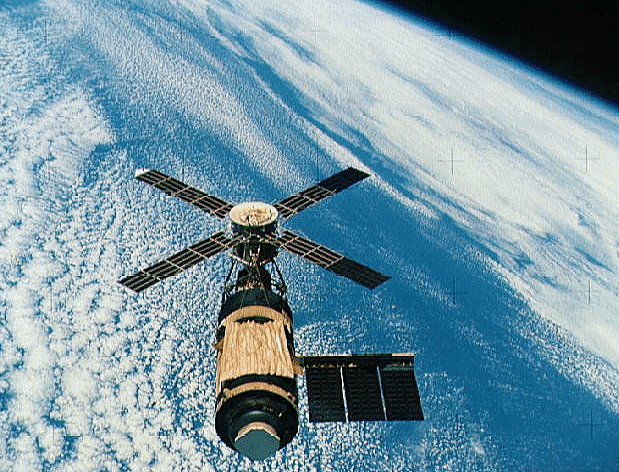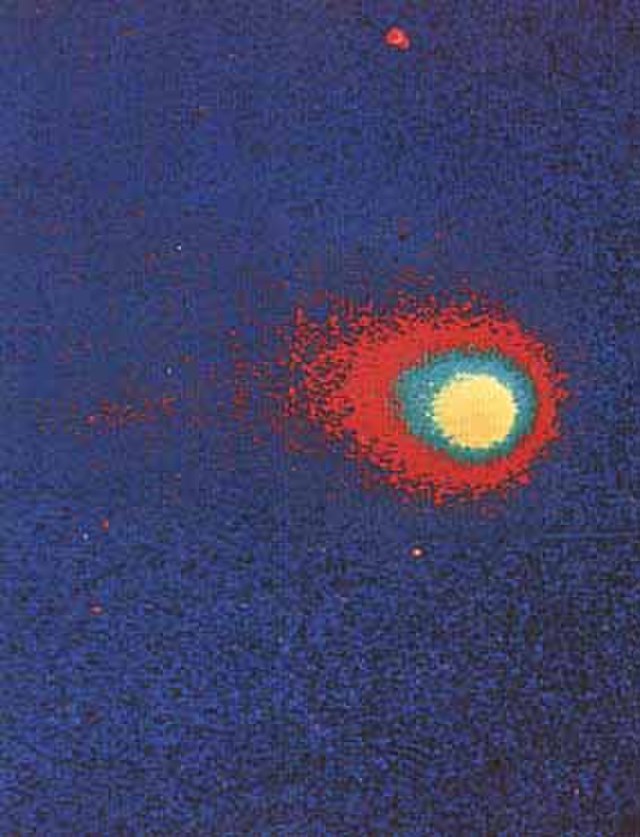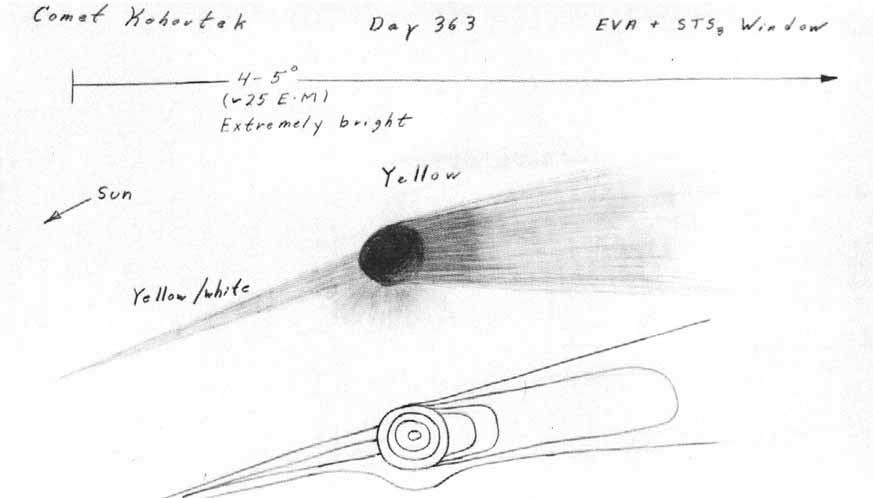This Month in Astronomical History: December 2023
Stephen Maran
 Each month as part of this series from the AAS Historical Astronomy Division (HAD), an important discovery or memorable event in the history of astronomy will be highlighted. This month, Stephen P. Maran writes about the 50th anniversary of the extravehicular activity to photograph a comet from space. Interested in writing a short (500-word) column? Instructions along with previous history columns are available on the HAD web page.
Each month as part of this series from the AAS Historical Astronomy Division (HAD), an important discovery or memorable event in the history of astronomy will be highlighted. This month, Stephen P. Maran writes about the 50th anniversary of the extravehicular activity to photograph a comet from space. Interested in writing a short (500-word) column? Instructions along with previous history columns are available on the HAD web page.
Comet Kohoutek, Skylab, and More
25 December 2023 marks the 50th anniversary of the extravehicular activity (EVA; “space walk”) to photograph a comet from space. Astronauts William Pogue and Gerald Carr exited NASA’s Skylab space station to image Comet Kohoutek 1973f in the far ultraviolet while at close angular separation from the Sun. They positioned the camera in shadow from a spacecraft structure to block the Sun from the field of view.1
Scientist astronaut Edward Gibson completed the crew of this, the fourth Skylab flight. None of the crew had flown in space before; it was NASA’s largest all-rookie flight crew up to that time. The space agency extended the originally planned 56-day flight to a record 84 days, prompted largely by the unexpected opportunity to observe the comet. The flight launched on 16 November; the crew began observing the comet on 13 December. (All dates in this article are 1973 unless stated otherwise. The permanent designation of this comet is C/1973 E1, but “1973f” is used here because that term is found in titles and texts of most papers that we mention; “1973XII was also in the literature.) Lubos Kohoutek (Hamburg Observatory) found the comet on 18 March, on plates exposed earlier.2 That date was less than two months before the first Skylab launch, which placed the uncrewed spacecraft and its attached Apollo Telescope Mount (ATM) solar observatory in orbit, preparatory to three crewed visits.
The ATM was equipped with multiple instruments covering the visual, ultraviolet, far ultraviolet, and x-ray regions. They included a white-light coronagraph (developed by R. M. Macqueen and the High Altitude Observatory), which obtained about 1600 images of the comet, including some with linear polarizing filters.3 It was not detected in X-rays.
The Skylab payload was enhanced for the fourth flight with a Far UV Electrographic Camera, adapted from the backup model of George Carruthers’ (Naval Research Laboratory) Far-UV Camera/Spectrograph on the Apollo 16 mission, which remained on the Moon.4 This payload addition was the first time a new instrument was brought to a spacecraft after that vessel was in orbit. Space technology in 1973 was much less advanced. The output from Skylab cameras and spectrographs was recorded on photographic film, for return to the ground with the crew. Extraction of exposed film from ATM instruments and loading new film into them required EVAs. The solar and cometary experiments were operated by astronauts, not from mission control. The astronauts also reoriented Skylab when necessary for some observations.
The crew had preflight instruction in cometary science, including a talk on comet tails by Freeman D. Miller (University of Michigan). As a result, when Gibson discovered the comet’s anti-tail on 29 December while looking through his sun visor during an EVA, he immediately knew what it was.5 His pencil sketches of the comet on that and other dates were transmitted to the ground by downlink video. They are now at the National Air and Space Museum.
The anti-tail was observed in the infrared as part of a 10-day sequence of post-perihelion observations at multiple wavelengths by Edward P. Nye (University of Minnesota), who easily located the comet in daylight by scanning in the mid-infrared at 10.6 µm at the predicted position. The data indicated that particles in the main tail differed from those in the anti-tail. Nye’s observing team was not subject to the same rigors as the EVA astronauts but labored at temperatures sometimes below -10 deg F.6 Zedenek Sekanina (Jet Propulsion Laboratory) analyzed the anti-tail data, confirming physical differences in dust particles of the anti-tail vs. the main tail and coma.7
Additional ground-based infrared observations included multichannel photometry at the University of Arizona, where comparison of infrared and visual data suggested that the comet nucleus diameter was 10 to 15 km.8 There was not yet a civilian infrared observatory in space, but interferometric infrared spectroscopic observations of molecular emissions from Kohoutek were attempted on a NASA Convair 990 aircraft. (The Kuiper Airborne Observatory was inaugurated in 1975.)9
Kohoutek was the first comet to be detected at radio wavelengths. The 1667- and 1665-MHz lines of the OH radical were observed with the Nançay radio telescope in absorption in December and then in emission in January 1974.10 Another objective of the radio observations was a search for parent molecules from the frozen nucleus that sublimate and subsequently dissociate to yield atoms and smaller molecules that are commonly found in comets. Detections of parent molecules methyl cyanide (CH3CN) and hydrogen cyanide (HCN) were made with the 11-m NRAO antenna on Kitt Peak.11,12
A Lyman-alpha “hydrogen corona” had been detected in earlier comets, so studies of that phenomenon were organized for Kohoutek. The ultraviolet observations with Skylab instruments were complemented by investigations with equipment that was already in Earth orbit or in interplanetary space, or that could be readily prepared for sub-orbital missions. The hydrogen corona had been observed with the ultraviolet spectrometer on Mariner 10 during 11-24 January 1974 (the probe had been launched just 13 days earlier than the fourth Skylab flight). The results traced the Lyman-alpha emission across 30 million km and revealed a brief episode of enhanced hydrogen production rate perhaps indicative of an additional hydrogen parent molecule, besides water.13 The Princeton 0.8-meter telescope with spectrometer on the Copernicus satellite had detected Lyman-alpha emission from Kohoutek at high spectral resolution. However, searches for deuterium and OH were negative.14
Kohoutek’s spectrum at 1200-3200 ångstroms was measured with a Johns Hopkins University instrument on an Aerobee rocket launched on 5 January 1974, from White Sands, New Mexico.15 Three days later, a Naval Research Laboratory payload that included a Far-UV instrument unit (actually the backup for Apollo 16) flew on another Aerobee.16 The spectrum at 3000-4600 å was observed from a NASA Convair 990, flying at 41,000 ft (about 12.5 km) altitude off the Pacific coast of Washington (state) on 24 January 1974.17 Visible-light observations were numerous and important. Early results addressed the long-standing issue that, while it was widely assumed that comets contain substantial water, consistent with Fred Whipple’s famous “dirty snowball” theory, water had not been detected in a comet prior to Kohoutek. However, George Herbig (Lick Observatory) detected the water ion H2O+ spectrum at 6200 A at high dispersion with the Lick 3-m telescope in observations of the inner coma on 9 January 1974, confirming water in a comet.18 That feature had been observed as early as 29 October, in collective light from coma and tail at Asiago Astrophysical Observatory but was not then identified.19 Later, the same ion was detected in spectra of the tail taken at Wise Observatory in the Negev Desert, where observations extended to mid-February 1974.20
Ground observers obtained numerous photographs. The new Joint Observatory for Cometary Research on South Baldy (altitude 10,615 feet) near Socorro, New Mexico, began operating in late 1973. The 14-inch f/2 Schmidt camera was purpose-built to observe large-scale plasma phenomena in comet tails, recording 8X10-degree fields on 4x5-inch plates. Its extensive observations of Kohoutek included photographs of a striking 5-million-km long swan-shaped structure at 0.l AU from the head of the comet on 11 January 1974. The so-called “Swan” was likely a late stage in a disconnection event, when a section of the ion tail separated from the comet.21 Observers using the 48- and 18-inch Schmidt cameras on Palomar Mountain were asked to photograph Kohoutek when feasible, during programs with other objectives.22
Although professional astronomers had some success from the ground, the optimistic initial predictions of the comet’s brightness and visibility from Earth that were touted in the popular news media left the general public greatly disappointed. Some people even complained to Congress because they had purchased binoculars and telescopes for the event.23 Also coincidental to the Skylab mission, the USSR launched Soyuz 13. It was the first time that the two nations had crews in orbit at the same time, 18-26 December. However, there was no coordination between the two. Even though the cosmonauts operated an Orion 2 Space Observatory, with a 240-mm telescope and objective prism spectrograph for stellar observations, there was no official report of about the comet.

Fig. 1: Skylab 4 in orbit. Credit: NASA. https://heasarc.gsfc.nasa.gov/Images/skylab/skylab4_orbit.gif

Fig. 2: False color enhancement of black-and-white photograph of Comet Kohoutek (1973f) photographed in the 125 nm–160 nm region during an extravehicular activity (“spacewalk”) on 25 December 1973 with an electrographic camera on Skylab. Credit: NASA

Fig. 3: Sketches of Comet Kohoutek made by Edward G. Gibson, scientist pilot of the third Skylab manned mission, illustrating the crew's collective impressions of the comet's appearance on 29 December 1973. The scale is E-M units (Earth-Moon distance, approximately 380 000 km). Credit: NASA. https://history.nasa.gov/SP-404/ch4.htm#4.18

Fig. 4: Comet Kohoutek and stars, in a false color enhancement of an image from the electrographic camera on Skylab, filtered for wavelengths from 125 to 160 nm. Credit: NASA. https://history.nasa.gov/SP-404/ch4.htm#4.14
References
- Uri, John. 2018. “Skylab 4: Final Mission Launches to Skylab,” https://www.nasa.gov/history/skylab-4-final-mission-launches-to-skylab/.
- Kohoutek, Lubos. “On the discovery of Comet Kohoutek (1973f),” Icarus, 23, 491-492.
- MacQueen, R.M., Hildner, E., Munro, R.H., Poland, A.I., Ross, C.L., Keller, H.U., Schmidt, H.U. 1974. “Photography of Comet Kohoutek by the Skylab White Light Coronagraph,” in Comet Kohoutek, ed. G.A. Gary, NASA SP-355, 19.
- Carruthers, G.R., Opalt, C.B., Page, T.L., Meier, R.R., D.K. Prinz, “Lyman-α imagery of Comet Kohoutek,” Icarus, 23, 526-537. Note that Chet B. Opal’s name was misspelled by Icarus.
- Gibson, E.G. 1974, “Visual Observations of Comet Kohoutek from Skylab III,” Icarus, 23, 493-501.
- Ney, E.P. 1974. “Infrared Observations of Comet Kohoutek Near Perihelion,” Ap. J., 189, L141-L143.
- Sekanina, Z. 1974. “On the nature of the anti-tail of Comet Kohoutek (1973f) I. A working model,” Icarus, 23, 502-518.
- Rieke, G.H., Lee, T.A. 1974. “Photometry of Comet Kohoutek (1973f),” Nature, 248, 737-740.
- Barbieri, C, Cosmovici, C.B., Michel, K.W., Nishimura, T., Roche, A.E. 1974. “Near-infrared observations of the dust coma of Comet Kohoutek (1973f) with a tilting-filter Fabry-Perot photometer,” Icarus, 23, 568-576.
- Biraud, F., Bourgois, G., Crovisier, J., Fillit, R., Gerard, E., Kazes, I. 1974. “OH Observation of Comet Kohoutek (1973f) at 18 cm Wavelength,” Astronomy. & Astrophysics., 34, 163-166.
- Ulich, B. L., E. K. Conklin 1974. “Detection of methyl cyanide in Comet Kohoutek,” Nature, 248, 121–122.
- Buhl, D., Huebner, W.F., Snyder, L.E. 1976. “Detection of molecular microwave transitions in the 3 mm wavelength range in Comet Kohoutek (1973f),” in Donn, B., Mumma, M.J., Jackson, W.M., Ahearn, M., Harrington, R., eds., The Study of Comets, Part 1, NASA SP-393-PT-1, 258-271.
- Kumar, S., Holberg, J., Broadfoot, A.L., Belton, M.J.S. 1979. “The Lyman-α Observations of Comet Kohoutek from Mariner 10,” Astrophysical. Journal., 232, 616-623.
- 14. Drake, J.F., Jenkins, E.B., Bertaux, J.L., Festou, M., Keller, H.U. 1976. “Lyman-alpha Observations of Comet Kohoutek 1973 XII with Copernicus,” Astrophysical. Journal., 232, 302-311.
- Feldman, P.D., Takacs, P.Z., Fastie, W.G., Donn, B. 1974. “Rocket Ultraviolet Spectrophotometry of Comet Kohoutek (1973f),” Science, 185, 705-707.
- Meier, R.R., Opal, C.B., Keller, H.U., Page, T.L., Carruthers, G.R. 1976. “Hydrogen Production Rates from Lyman-α Images of Comet Kohoutek (1973XII),” Astronomy. & Astrophysics., 52, 283-290.
- Harvey, G.A. 1974, “Ultraviolet Hydroxyl of Comet Kohoutek on January 24, 1974.” in Comet Kohoutek, ed. G.A. Gary, NASA SP-355, 19.
- 18. Herbig, G.H. 1973, I.A.U. Circ. 2596.
- Benvenuti, P., Wurm, K. 1974. “Spectroscopic Observations of Comet Kohoutek (1973f),” Astronomy & Astrophysics., 31, 121-122.
- Wehinger, P.A., Wyckoff, S. 1974. “H20+ in the Tail Spectrum of Comet Kohoutek (1973f),” in Comet Kohoutek, ed. G.A. Gary, NASA SP-355, 103-105.
- Brandt, J.C. 1981. “The JOCR Program,” in Brandt, J.C., Greenberg, J.M., Donn, B., Rahe, J. eds., Modern Observational Techniques for Comets, NASA-CR-165006, 171-184.
- Kowal, C.T. 1974. “Hale Observatories Photographs of Comet Kohoutek,” in Comet Kohoutek, ed. G.A. Gary, NASA SP-355, 31-32.
- Regas, D. 2013. “Remembering Comet Kohoutek,” Sky & Telescope, 125, No. 4, 32-37.
Further Reading
- Comet Kohoutek, ed. Gilmer Allen Gary. 1974. NASA SP-355.
- Icarus, 23, No. 4, 489-634 (1974 December; special issue).

